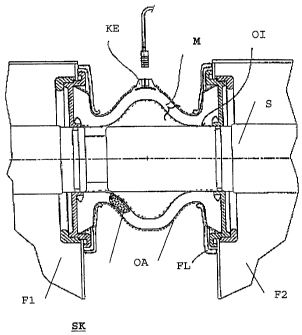Some of the information on this Web page has been provided by external sources. The Government of Canada is not responsible for the accuracy, reliability or currency of the information supplied by external sources. Users wishing to rely upon this information should consult directly with the source of the information. Content provided by external sources is not subject to official languages, privacy and accessibility requirements.
Any discrepancies in the text and image of the Claims and Abstract are due to differing posting times. Text of the Claims and Abstract are posted:
| (12) Patent: | (11) CA 2501143 |
|---|---|
| (54) English Title: | CONNECTING SLEEVE FOR A BUS BAR CONNECTION IN A GAS-INSULATED SWITCHBOARD SYSTEM |
| (54) French Title: | MANCHON POUR COUPLAGE DES BARRES DANS UNE INSTALLATION DE DISTRIBUTION ETANCHE AUX GAZ |
| Status: | Deemed expired |
| (51) International Patent Classification (IPC): |
|
|---|---|
| (72) Inventors : |
|
| (73) Owners : |
|
| (71) Applicants : |
|
| (74) Agent: | GOWLING WLG (CANADA) LLP |
| (74) Associate agent: | |
| (45) Issued: | 2010-11-30 |
| (86) PCT Filing Date: | 2003-08-16 |
| (87) Open to Public Inspection: | 2004-04-22 |
| Examination requested: | 2006-09-25 |
| Availability of licence: | N/A |
| (25) Language of filing: | English |
| Patent Cooperation Treaty (PCT): | Yes |
|---|---|
| (86) PCT Filing Number: | PCT/EP2003/009081 |
| (87) International Publication Number: | WO2004/034535 |
| (85) National Entry: | 2005-04-04 |
| (30) Application Priority Data: | ||||||
|---|---|---|---|---|---|---|
|
A connecting sleeve generally used for a bus bar connection is produced from
an
insulating elastic material, often an elastomer material, having insulating
properties
which are deteriorated by partial discharges and decrease over the operating
time of
the switchboard system. According to the invention, so-called partial
discharge
measuring methods must be carried out, inter alia also in the UHF range (UHF:
ultra
high frequency), in order to identify damaging effects on the insulating
material in
time. For the reliable and simple detection of the measuring signals, the
connecting
sleeve (M) has an outer, electroconductive surface (OA) which is earthed, and
an
inner, electroconductive surface (OI) to which the voltage potential of the
bus bar (S)
is applied, in addition to a coupling electrode (KE) which is integrated into
the
insulating material (I).
Dans le domaine du couplage des barres, on utilise souvent un manchon, formé dans une matière élastique, isolante, souvent dans un plastique élastomère, dont les propriétés isolantes se dégradent par décharges partielles et diminuent au cours de temps de fonctionnement de l'installation de distribution. L'objectif de l'invention est de reconnaître à temps les effets de détérioration sur la matière isolante. A cet effet, on met en oeuvre des procédés de mesure des décharges partielles, ou également autour de la partie ultra haute fréquence. L'objectif de l'invention est de permettre une collecte, plus sûre et plus simple à manipuler, des signaux de mesure. A cet effet, le manchon (M) présente une surface (OA) électroconductrice, extérieure, laquelle est mise à la terre, et une surface (OI) électroconductrice, intérieure, à laquelle le potentiel de tension de la barre (S) est ajustée, et le manchon (M) présente également une électrode de couplage (KE) insérée dans la matière (I) isolante. Grâce à ces mesures, un dispositif de mesure sûr est mis en place, dans lequel le capteur (électrode de couplage KE) se trouve à l'extérieur du compartiment à gaz de l'installation, ce qui permet d'éviter une opération gazeuse lors de l'échange du capteur. Grâce à la conception du manchon (M), le capteur (électrode de couplage KE) peut être doté d'une sensibilité élevée à la décharge partielle.
Note: Claims are shown in the official language in which they were submitted.
Note: Descriptions are shown in the official language in which they were submitted.

For a clearer understanding of the status of the application/patent presented on this page, the site Disclaimer , as well as the definitions for Patent , Administrative Status , Maintenance Fee and Payment History should be consulted.
| Title | Date |
|---|---|
| Forecasted Issue Date | 2010-11-30 |
| (86) PCT Filing Date | 2003-08-16 |
| (87) PCT Publication Date | 2004-04-22 |
| (85) National Entry | 2005-04-04 |
| Examination Requested | 2006-09-25 |
| (45) Issued | 2010-11-30 |
| Deemed Expired | 2013-08-16 |
There is no abandonment history.
| Fee Type | Anniversary Year | Due Date | Amount Paid | Paid Date |
|---|---|---|---|---|
| Registration of a document - section 124 | $100.00 | 2005-04-04 | ||
| Application Fee | $400.00 | 2005-04-04 | ||
| Maintenance Fee - Application - New Act | 2 | 2005-08-16 | $100.00 | 2005-06-29 |
| Registration of a document - section 124 | $100.00 | 2006-01-19 | ||
| Maintenance Fee - Application - New Act | 3 | 2006-08-16 | $100.00 | 2006-07-04 |
| Request for Examination | $800.00 | 2006-09-25 | ||
| Maintenance Fee - Application - New Act | 4 | 2007-08-16 | $100.00 | 2007-07-09 |
| Maintenance Fee - Application - New Act | 5 | 2008-08-18 | $200.00 | 2008-08-08 |
| Maintenance Fee - Application - New Act | 6 | 2009-08-17 | $200.00 | 2009-07-27 |
| Maintenance Fee - Application - New Act | 7 | 2010-08-16 | $200.00 | 2010-06-25 |
| Final Fee | $300.00 | 2010-09-15 | ||
| Maintenance Fee - Patent - New Act | 8 | 2011-08-16 | $200.00 | 2011-08-02 |
Note: Records showing the ownership history in alphabetical order.
| Current Owners on Record |
|---|
| AREVA T&D SA |
| Past Owners on Record |
|---|
| ALSTOM |
| RUHLAND, SIEGFRIED |
| STARCK, THIERRY |